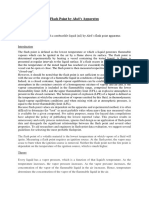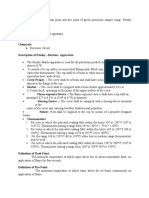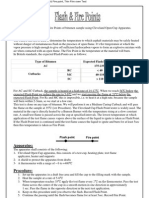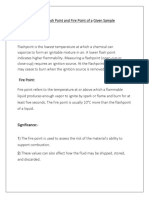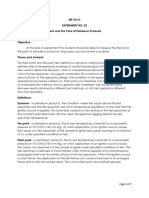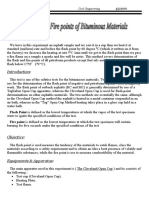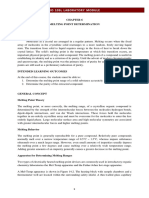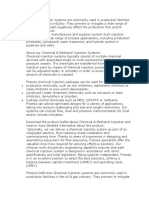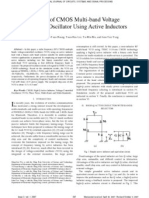Pensky Martens
Pensky Martens
Uploaded by
harry_chemCopyright:
Available Formats
Pensky Martens
Pensky Martens
Uploaded by
harry_chemOriginal Description:
Copyright
Available Formats
Share this document
Did you find this document useful?
Is this content inappropriate?
Copyright:
Available Formats
Pensky Martens
Pensky Martens
Uploaded by
harry_chemCopyright:
Available Formats
PENSKYMARTENS CLOSED-CUP TEST
In the PenskyMartens closed-cup flash-point test, a brass test cup is filled with a
test specimen and fitted with a cover. The sample is heated and stirred at
specified rates depending on the material that is being tested. An ignition source is
directed into the cup at regular intervals with simultaneous interruption of
stirring until a flash that spreads throughout the inside of the cup is seen. The
corresponding temperature is its flash point.
PenskyMartens closed cup is sealed with a lid through which the ignition
source can be introduced periodically. The vapour above the liquid is assumed to
be in reasonable equilibrium with the liquid. Closed cup testers give lower
values for the flashpoint than open-cup testers(typically 510 K) and are a better
approximation to the temperature at which the vapour pressure reaches the
"lower flammable limit" (LFL).
The flash point of a volatile material is the lowest temperature at which vapors of a
fluid will ignite. Measuring a flash point requires an ignition source. At the flash
point, the vapor may cease to burn when the ignition source is removed.
The flash point is not to be confused with the autoignition temperature (which does
not require an ignition source) or with the fire point (the temperature at which the
vapor continues to burn after being ignited).
Neither the flash point nor the fire point is dependent on the temperature of the
ignition source, which is much higher.
There are two basic types of flash point measurement: open cup and closed cup.
In open cup devices the sample is contained in an open cup which is heated, and
at intervals a flame is brought over the surface. The measured flash point will
actually vary with the height of the flame above the liquid surface, and at
sufficient height the measured flash point temperature will coincide with the fire
point. The best known example is the Cleveland open cup (COC).
There are two types of closed cup testers: non-equilibrium, such as PenskyMartens where the vapors above the liquid are not in temperature equilibrium
with the liquid, and equilibrium, such as Small Scale (commonly known as
Setaflash) where the vapors are deemed to be in temperature equilibrium with
the liquid. In both these types the cups are sealed with a lid through which the
ignition source can be introduced. Closed cup testers normally give lower values
for the flash point than open cup (typically 510 C or 918 F lower) and are a
better approximation to the temperature at which the vapor pressure reaches
the lower flammable limit.
The flash point is an empirical measurement rather than a fundamental physical
parameter. The measured value will vary with equipment and test protocol
variations, including temperature ramp rate (in automated testers), time allowed
for the sample to equilibrate, sample volume and whether the sample is stirred.
Methods for determining the flash point of a liquid are specified in many
standards. For example, testing by the Pensky-Martens closed cup method is detailed
in ASTM D93, IP34, ISO 2719, DIN 51758, JIS K2265 and AFNOR M07-019.
Determination of flash point by the Small Scale closed cup method is detailed in
ASTM D3828 and D3278, EN ISO 3679 and 3680, and IP 523 and 524.
CEN/TR 15138 Guide to Flash Point Testing and ISO TR 29662 Guidance for
Flash Point Testing cover the key aspects of flash point testing.
Gasoline (petrol) is a fuel for use in a spark-ignition engine. The fuel is mixed with air
within its flammable limits and heated above its flash point, then ignited by
the spark plug. To ignite, the fuel must have a low flash point, but in order to
avoid preignition caused by residual heat in a hot combustion chamber, the fuel
must have a high autoignition temperature.
Diesel fuel flash points vary between 52 and 96 C (126 and 205 F). Diesel is
suitable for use in a compression-ignition engine. Air is compressed until it has been
heated above theautoignition temperature of the fuel, which is then injected as a
high-pressure spray, keeping the fuel-air mix within flammable limits. In a
diesel-fueled engine, there is no ignition source (such as the spark plugs in a
gasoline engine). Consequently, diesel fuel must have a high flash point and a
low autoignition temperature.
Jet fuel flash points also vary with the composition of the fuel. Both Jet A and Jet
A-1 have flash points between 38 and 66 C (100 and 151 F), close to that of offthe-shelf kerosene. Yet both Jet B and JP-4 have flash points between 23 and
1 C (9 and 30 F).
You might also like
- A Guide to Perfume Production - A Selection of Vintage Articles on the Methods and Ingredients of PerfumeryFrom EverandA Guide to Perfume Production - A Selection of Vintage Articles on the Methods and Ingredients of PerfumeryRating: 5 out of 5 stars5/5 (2)
- Plants Vs ZombiesDocument11 pagesPlants Vs Zombiesharry_chemNo ratings yet
- HSEMP ContentsDocument6 pagesHSEMP Contentsharry_chem100% (1)
- Oracle PL SQL Interview Questions For 3 - Years ExperienceDocument89 pagesOracle PL SQL Interview Questions For 3 - Years Experiencenirmala bogireddy50% (2)
- Wartsila Engine 18V50DFDocument3 pagesWartsila Engine 18V50DFAniket Gaikwad100% (1)
- Telecom Module (II1-0079) Draft BookletDocument15 pagesTelecom Module (II1-0079) Draft BookletLeopardLapatratNo ratings yet
- Flash PointDocument8 pagesFlash Pointمحمود محمدNo ratings yet
- Flash Point by Abel's ApparatusDocument3 pagesFlash Point by Abel's ApparatusAbhishek JoshiNo ratings yet
- Flash PointDocument10 pagesFlash Pointvv vvNo ratings yet
- Flash Point - Wikipedia, The Free EncyclopediaDocument3 pagesFlash Point - Wikipedia, The Free Encyclopedianishant361No ratings yet
- Flash and Fire PointDocument6 pagesFlash and Fire Pointabth99No ratings yet
- Flash Anf Fire PointDocument8 pagesFlash Anf Fire PointMUHAMMAD AKRAM100% (2)
- II. Properties of Fuels Density, Specific Volume and Specific GravityDocument24 pagesII. Properties of Fuels Density, Specific Volume and Specific Gravitybaeby chuNo ratings yet
- Flash and Fire Point of Lubricant ExperimentDocument5 pagesFlash and Fire Point of Lubricant ExperimentShanti Kiran Z100% (1)
- Flash and Fire Point TestDocument7 pagesFlash and Fire Point TestAisyah Ibrahim89% (18)
- Fuel TestsDocument33 pagesFuel Testsmuhammad.ali.shehzad22No ratings yet
- Balitian - Me Lab - Exp5Document9 pagesBalitian - Me Lab - Exp5JB_0929No ratings yet
- Flash and Fire Point TestDocument4 pagesFlash and Fire Point TestSAQAR ALGHAMDINo ratings yet
- Fe 205 Labaratory Report 1Document6 pagesFe 205 Labaratory Report 1Hüsamettin KirazNo ratings yet
- 4.flash & Fire PointDocument8 pages4.flash & Fire PointMohammed MigdadyNo ratings yet
- Refining of Oil Lab: Experiment NameDocument9 pagesRefining of Oil Lab: Experiment NameAmmar YasserNo ratings yet
- Flash Point ApparatusDocument5 pagesFlash Point ApparatusKavindu UmayangaNo ratings yet
- Melting PointDocument8 pagesMelting PointCuteboy SabitNo ratings yet
- Flash and Fire Point Test and Grease Drop Test PT 3Document14 pagesFlash and Fire Point Test and Grease Drop Test PT 3jhonanthonyapiagNo ratings yet
- Melting PointDocument4 pagesMelting PointShama Al-ShadidiNo ratings yet
- 200005A - P1 - Flash Point ApparatusDocument11 pages200005A - P1 - Flash Point Apparatusaruthlugnesha2001No ratings yet
- Practical Petroleum Properties Lab. 2 Year Level: University of ZakhoDocument7 pagesPractical Petroleum Properties Lab. 2 Year Level: University of ZakhoMalik ZainNo ratings yet
- EEDocument15 pagesEEWasif MalikNo ratings yet
- Flash Point and Fire Point - FinalDocument33 pagesFlash Point and Fire Point - FinalAnonymous QM0NLqZONo ratings yet
- ME2033: Thermodynamics of Heat and Work Transfer Devices:: Semester: 4Document13 pagesME2033: Thermodynamics of Heat and Work Transfer Devices:: Semester: 4aruthlugnesha2001No ratings yet
- Flash and Fire PointDocument4 pagesFlash and Fire PointNur SyahidaNo ratings yet
- Flash PointDocument2 pagesFlash PointShailendra ThakurNo ratings yet
- Flash & Fire PointDocument2 pagesFlash & Fire PointHarsh ThakurNo ratings yet
- Flash Point and Fire PointDocument2 pagesFlash Point and Fire PointHitesh N. PanchalNo ratings yet
- MMMMM MergedDocument11 pagesMMMMM Mergedمرتضى حامد كاظم رحيمNo ratings yet
- Pensky Marten ApparatusDocument2 pagesPensky Marten Apparatusghambira100% (6)
- 06 Flash and Fire PointDocument9 pages06 Flash and Fire PointanmarNo ratings yet
- Flash & Fire PointDocument3 pagesFlash & Fire PointAnkur BansalNo ratings yet
- Flash Point and Fire PointDocument3 pagesFlash Point and Fire PointM ZarakNo ratings yet
- FlammabilityDocument10 pagesFlammabilityHamza MasalawalaNo ratings yet
- Flash Point of Bitumen SampleDocument8 pagesFlash Point of Bitumen Samplemwaqas250No ratings yet
- Boiling PTDocument2 pagesBoiling PTmominhadiNo ratings yet
- Flash Point and Fire PointDocument10 pagesFlash Point and Fire Pointahmed tobaNo ratings yet
- Flash and Fire PointDocument3 pagesFlash and Fire PointH.V.THENUWARANo ratings yet
- Flash & Fire Point Test of BitumenDocument8 pagesFlash & Fire Point Test of BitumenDakshraj RathodNo ratings yet
- LITERATURE REVIEW Exp 6Document3 pagesLITERATURE REVIEW Exp 6Meenakchi Anuradha100% (2)
- Cloud and Pour PointDocument2 pagesCloud and Pour PointJennifer Galloway0% (2)
- Melting Point - Wikipedia, The Free EncyclopediaDocument3 pagesMelting Point - Wikipedia, The Free Encyclopediadonodoni0008No ratings yet
- Experiment 2- Flash Point and Fire Point of Petroleum ProductsDocument7 pagesExperiment 2- Flash Point and Fire Point of Petroleum ProductsNiceous ReignsNo ratings yet
- Flash PointDocument6 pagesFlash PointAbhilash AbhiNo ratings yet
- Difference of Flash Point and Ignition Temperature, Flammable & Combustible, Water & Oil Boiling PointDocument11 pagesDifference of Flash Point and Ignition Temperature, Flammable & Combustible, Water & Oil Boiling PointGaudencio BoniceliNo ratings yet
- Fire Combustion Fire Testing Building Codes: FlammabilityDocument3 pagesFire Combustion Fire Testing Building Codes: FlammabilityMarverick Solmoro-Caraig EvangelistaNo ratings yet
- Meltingpoint PDFDocument4 pagesMeltingpoint PDFShama Al-ShadidiNo ratings yet
- Crude Oil and Refined Product Fingerprinting: Principles: Flash PointDocument2 pagesCrude Oil and Refined Product Fingerprinting: Principles: Flash PointalokaNo ratings yet
- 6 Flash Point and Fire Point 1Document16 pages6 Flash Point and Fire Point 1حسامNo ratings yet
- 11 Flash and Fire Point of Bitumen - SayeedDocument2 pages11 Flash and Fire Point of Bitumen - Sayeedlm hasnainNo ratings yet
- Flash & Fire PointsDocument2 pagesFlash & Fire PointsMalik ZainNo ratings yet
- BIO 105L - CHAPTER 6 - Melting Point DeteminationDocument4 pagesBIO 105L - CHAPTER 6 - Melting Point DeteminationFranchiezca AoananNo ratings yet
- Pensky Martin (2015uch1708)Document6 pagesPensky Martin (2015uch1708)Manoj MorwalNo ratings yet
- Lab Report Exp 3Document4 pagesLab Report Exp 3Anonymous T7vjZG4otNo ratings yet
- 2210 - Melting Points and Mixed Melting PointsDocument13 pages2210 - Melting Points and Mixed Melting PointsAmalia Siller0% (1)
- Flash Pont Test (Closed-Cup) Standard Operating Procedure: ScopeDocument2 pagesFlash Pont Test (Closed-Cup) Standard Operating Procedure: ScopeShunmuganathanNo ratings yet
- Abstract:Introduction:Equipments & Apparatus: Objective: ..2Document3 pagesAbstract:Introduction:Equipments & Apparatus: Objective: ..2Mohammed MigdadyNo ratings yet
- Lab 3Document5 pagesLab 3teaNo ratings yet
- Marvel Carbureter and Heat Control: As Used on Series 691 Nash Sixes Booklet SFrom EverandMarvel Carbureter and Heat Control: As Used on Series 691 Nash Sixes Booklet SNo ratings yet
- FE440# Series Orifice Assembly With D-D/2 Taps: HydropneumaticsDocument1 pageFE440# Series Orifice Assembly With D-D/2 Taps: Hydropneumaticsharry_chemNo ratings yet
- Ariel Overview WebDocument2 pagesAriel Overview Webharry_chemNo ratings yet
- Progressive Cavity Pump O&M PDFDocument120 pagesProgressive Cavity Pump O&M PDFharry_chemNo ratings yet
- Lead - Lag ControllerDocument2 pagesLead - Lag Controllerharry_chemNo ratings yet
- Chemical Injection Systems Are Commonly Used in Production Facilities in The Oil and Gas IndustryDocument2 pagesChemical Injection Systems Are Commonly Used in Production Facilities in The Oil and Gas Industryharry_chemNo ratings yet
- Tetra PakDocument11 pagesTetra Pakharry_chemNo ratings yet
- Lithium Ion BatteryDocument31 pagesLithium Ion Batteryharry_chem100% (1)
- Wastewater EngineeringDocument2 pagesWastewater Engineeringharry_chemNo ratings yet
- Martinsville User ManualDocument116 pagesMartinsville User Manualharry_chemNo ratings yet
- Necessary Information For Dryer CalculationDocument1 pageNecessary Information For Dryer Calculationharry_chemNo ratings yet
- Progressive Cavity Pump O&MDocument120 pagesProgressive Cavity Pump O&Mharry_chemNo ratings yet
- Round Date Venue Organizer: 1 ChikmagalurDocument1 pageRound Date Venue Organizer: 1 Chikmagalurharry_chemNo ratings yet
- A Microwave OvenDocument9 pagesA Microwave Ovenharry_chem100% (1)
- Mix-Xylene P SafetyguideDocument1 pageMix-Xylene P Safetyguideharry_chemNo ratings yet
- SR - No Parameter Unit Specification: Reliance Industries Limited, Maker Chambers IV, Nariman Point, MumbaiDocument1 pageSR - No Parameter Unit Specification: Reliance Industries Limited, Maker Chambers IV, Nariman Point, Mumbaiharry_chemNo ratings yet
- UBE Air Drying MembranesDocument8 pagesUBE Air Drying Membranesharry_chem100% (1)
- Mix-Xylene P ApplicationsDocument1 pageMix-Xylene P Applicationsharry_chemNo ratings yet
- (PDF Download) The Complete Guide To Blender Graphics: Computer Modeling and Animation: Volume 2 9th Edition John M. Blain Fulll ChapterDocument64 pages(PDF Download) The Complete Guide To Blender Graphics: Computer Modeling and Animation: Volume 2 9th Edition John M. Blain Fulll Chapterdauirslovo100% (4)
- Technical Data Sheet For Hdpe Pe 100, 315.0 MM X 28.6 MM DuctDocument1 pageTechnical Data Sheet For Hdpe Pe 100, 315.0 MM X 28.6 MM DuctJohn BenzNo ratings yet
- API To Create ItemDocument2 pagesAPI To Create ItembcmohanNo ratings yet
- Adhesive ListDocument2 pagesAdhesive ListOpenStudyNo ratings yet
- Effect of Steel Pins On Interface Shear Behavior of Segmental Concrete UnitsDocument7 pagesEffect of Steel Pins On Interface Shear Behavior of Segmental Concrete UnitsZahid BhuiyanNo ratings yet
- Designs of CMOS Multi-Band Voltage Controlled Oscillator Using Active InductorsDocument4 pagesDesigns of CMOS Multi-Band Voltage Controlled Oscillator Using Active Inductorsrahms79No ratings yet
- Example - 2 For UA - Practice by AHRIDocument8 pagesExample - 2 For UA - Practice by AHRInadia jalilNo ratings yet
- Eeezg 512Document11 pagesEeezg 512Semil ChaliawalaNo ratings yet
- Differentiation of Organic From InorganicDocument4 pagesDifferentiation of Organic From InorganicSHARENDRA INJALNo ratings yet
- SAP BI Repository DocumentorDocument120 pagesSAP BI Repository DocumentorleminhbkNo ratings yet
- Graphite Edge Controller Data Sheet - 0Document2 pagesGraphite Edge Controller Data Sheet - 0R Chilet L. AnthonyNo ratings yet
- 21-01-2024 - SR - Super60 - Elite, Target & LIIT-BTs - Jee-Main-GTM-15 - KEY & Sol'SDocument16 pages21-01-2024 - SR - Super60 - Elite, Target & LIIT-BTs - Jee-Main-GTM-15 - KEY & Sol'SAshwina JaikrishnanNo ratings yet
- Panasonic Service Manual g2 SeriesDocument82 pagesPanasonic Service Manual g2 SeriesAnthony RhodesNo ratings yet
- Emailing دوسية المهندس ابراهيم النوافلة-1Document61 pagesEmailing دوسية المهندس ابراهيم النوافلة-1ahmadalialhamaida19971015No ratings yet
- FLC Contisys Obd User Manual Ver5 0 0enDocument162 pagesFLC Contisys Obd User Manual Ver5 0 0enOctavio LópezNo ratings yet
- Liquid Penetrant TestingDocument51 pagesLiquid Penetrant TestingMurali Anirudh100% (1)
- Problem A. Architecture: InputDocument18 pagesProblem A. Architecture: InputCamilo Andres Martinez VargasNo ratings yet
- 387-Summary Gate AcademyDocument424 pages387-Summary Gate Academy40B Sushil UrkudeNo ratings yet
- 3RD Quarter ReviewDocument52 pages3RD Quarter ReviewMichelle Jane EvangelistaNo ratings yet
- Introduction To Digital Image ProcessingDocument81 pagesIntroduction To Digital Image ProcessingFinding_Nemo4100% (1)
- The Franck-Condon Principle in Diatomic Bound-Free TransitionsDocument17 pagesThe Franck-Condon Principle in Diatomic Bound-Free TransitionsSufiya BanoNo ratings yet
- Chapter 3 MethodologyDocument16 pagesChapter 3 MethodologyRea May De La TorreNo ratings yet
- Survey of Mathematics With Applications 9th Edition Angel Test BankDocument23 pagesSurvey of Mathematics With Applications 9th Edition Angel Test Bankshannontoddfbjgzpaiec100% (35)
- WD5000BUDTDocument2 pagesWD5000BUDTsentsieNo ratings yet
- An Information SystemDocument2 pagesAn Information SystemjhomerzongNo ratings yet
- AP Calculus BC 1998 Free-Response QuestionsDocument7 pagesAP Calculus BC 1998 Free-Response QuestionsepoxytocinNo ratings yet
- ETABS 2015 15.2.0-Design Details3Document2 pagesETABS 2015 15.2.0-Design Details3edgard aduvireNo ratings yet







